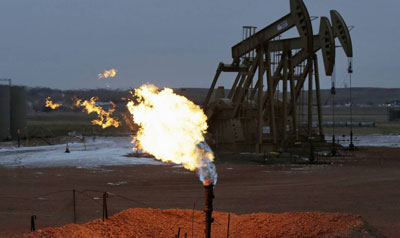Oil prices edge up as northern hemisphere moves into peak winter demand

Oil prices edged away from multi-year lows on Tuesday as the northern hemisphere moves into the peak-demand winter season, but mild weather and ballooning supplies mean that prices are expected to remain generally low well into 2016.
The global crude benchmark Brent LCOc1 was at $36.46 per barrel at 0213 GMT, under half a dollar above the 11-year low hit on Monday, and traders said the price jump was more related to a roll-over in contracts and the start of the peak demand winter season than because of changing fundamentals.
U.S. West Texas Intermediate (WTI) crude futures CLc1 were at 36.04 per barrel, up from 2009 lows of $33.98 during the previous session.
Despite the bounce, analysts said that further large price rises were unlikely.
BNP Paribas said that the amount of U.S. and European heating degree days had been 30 percent and 39 percent below the 10-year average since Dec. 7 respectively, and that days requiring heating were expected to remain 23-24 percent below normal until Jan. 4.
“In the next two weeks … the U.S., Europe and Russia will be particularly milder than normal,” the bank said.
An unusually mild start to winter has dominated the northern hemisphere, caused in part by the El Nino weather phenomenon, keeping heating oil demand lower than the norm.
The weak winter demand is seen clashing with an expected rise in supplies once Iran’s oil exports start to fully return after a lifting of western sanctions against Tehran.
Bank of America Merrill Lynch said Iranian output could rise by 600,000 barrels per day (bpd), from a current volume of around 1 million bpd within six months after sanctions end.
The International Energy Agency said that it expected Iran’s exports to rise by half a million bpd within 6-12 months of sanctions being lifted.
Iran’s barrels would add to an already oversupplied market that has seen prices fall by two-thirds since mid-2014, undercutting lows seen during the 2008 financial crisis and pulling oil to levels last seen over a decade ago.
U.S. crude prices have been firmer relative to their Brent equivalents recently, with Brent’s premium over WTI collapsing over 95 percent since its 2015 peak in February to under half a dollar.
WTI has been supported by a fall in drilling for shale oil this year. Prices were also supported by a congressional vote to end a 40-year-old ban on U.S. crude exports.
Brent, by contrast, has been weighed down by soaring production from Russia and OPEC. Iran’s expected additional supply has also dragged on Brent.
As a result, many analysts expect the Brent premium over U.S. crude to flip into a discount soon, but with both benchmarks remaining at low levels until late 2016 at the least.
Source: REUTERS – Oil prices edge up as northern hemisphere moves into peak winter demand




























